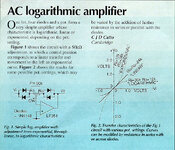neazoi
Advanced Member level 6

Hi,
I have seen many logarithmic DETECTORS, but I would like to find a logarithmic pre-AMPLIFIER that could operate from about 1MHz to 30MHz region.
I would like to use it for experimenting with different RF blocks.
I have seen this circuit which seems simple, but this is only for audio and I do not know if a fast opamp (which one?) will achieve the same result on HF.
My preference is on discrete circuits if possible (but not limited to them).
Could you help?
Thanks
I have seen many logarithmic DETECTORS, but I would like to find a logarithmic pre-AMPLIFIER that could operate from about 1MHz to 30MHz region.
I would like to use it for experimenting with different RF blocks.
I have seen this circuit which seems simple, but this is only for audio and I do not know if a fast opamp (which one?) will achieve the same result on HF.
My preference is on discrete circuits if possible (but not limited to them).
Could you help?
Thanks




